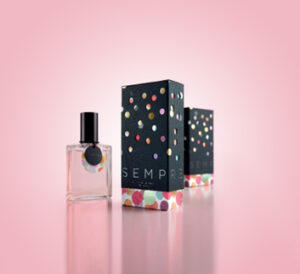Sustainability and the Future of Packaging
How Brands Can Adapt to Packaging Sustainability Needs While Maintaining Product Versatility
By Carl Asher, General Manager for Packaging & Sustainable Solutions at Neenah Paper & Packaging, a Mativ brand
Consumers are growing increasingly aware of sustainability efforts and overall Environmental, Social and Corporate Governance (ESG) requirements. In fact, a study conducted by the Breakthrough National Centre for Climate Restoration found that 77% of consumer respondents said plastic was the least environmentally responsible packaging, while paper was ruled the most environmentally friendly.
While giving brands a great excuse to develop materials that are biodegradable, there will be challenges in adapting to this trend while maintaining top-level products. However, by transitioning to paper packaging, brands can maintain product versatility and uniqueness, while also meeting urgent consumer demands.
How does packaging influence the brand experience for today’s sustainability-conscious consumer?
Packaging is an extension of the brand experience. The shape, color, vibrancy, texture, finish, weight, etc., all reinforce functional and responsive elements of the brand. From a functional perspective, the packaging may communicate the product’s uses and benefits. On the responsive side, the packaging may convey a sense of warmth, authenticity, heritage, or luxury.
In response to today’s sustainability-conscious consumer, we are seeing more brands use recycled content in their packaging. Consumers are made aware of a packaging’s recycled content through visual elements, such as logos and text, as well as tactile elements like uncoated papers with natural textures. Another area we see a lot of momentum in the sustainable packaging space is in the replacement of plastic inserts with paper, specifically paper with heavy recycled content. Both of these strategies help to amplify a brand’s sustainability values and validate a consumers’ product/brand selection.
How is paper packaging helping brands reach their sustainability goals, including reducing dunnage and DIM weight?

Modern sustainable mailers are puncture and water resistant, easy to seal, and simple for end consumers to open while also being curbside recyclable and made from post-consumer waste. Image courtesy of Neenah Paper & Packaging, a Mativ brand.
Brands have varying goals when it comes to sustainability, but some of the more common goals we see are around carbon footprint reduction and the replacement of non-recyclable components, mainly plastic. In both cases, paper packaging can be a great solution.
Traditionally, dunnage has consisted of materials like air pillows, bubble wrap, foam, peanuts, etc. A sustainably sourced lightweight text or writing paper, made with post-consumer waste, is a great alternative to some of these non-sustainable options.
Sustainable mailers are another way to marry consumer friendly packaging with sustainability. Modern sustainable mailers are puncture and water resistant, easy to seal, and simple for end consumers to open while also being curbside recyclable and made from post-consumer waste.
In addition, we believe there’s also an opportunity to couple sustainability with elevating the unboxing experience for consumers in ecommerce. For example, opting to add a colorful paper inside the box in a branded way to wrap an individual lightweight product is one way to elevate an unboxing experience.
What is the next frontier for sustainable packaging?
The younger generation is adding urgency and relevancy to climate change conversations and the importance of sustainability. They are figuratively, and literally, putting their collective monies where their mouths are and holding the brands they engage with accountable. The next frontier in sustainable packaging is more involvement and more engagement from brands – which should be a good thing.
The growth in ecommerce presents an opportunity for sustainable packaging to extend and elevate the brand experience, so that the package that arrives at your door feels as unique and special as if you had picked it up off the retail shelf.
Legislation will continue to influence sustainable packaging trends. In particular, European legislation has led the way for making European-based brands drastically change their raw material supply chains and disposal. As a result, the European brands we engage with have really strong sustainability platforms.
In the U.S., the increasing importance of ESG is being driven by consumers and investors who are signaling they only want to involve themselves with companies that ‘do-good.’ Sustainability is a core tenant of ESG.
I also think some brands are seeing, and will continue to see, smaller competitors being able to capture more market share by leading with a sustainability message.
How is the luxury segment leading the charge on sustainability?
Luxury brands are synonymous with brand recognition and often have a big retail and social media presence. Due to this expansive visibility, many luxury brands face a lot of sustainability scrutiny. Luxury purchasing attitudes are shifting with more and more consumers opting for sustainable and responsibly sourced products than ever before. As larger luxury brands meet this consumer demand by opting for sustainable options, they establish a new green standard for other aspirational brands.
Why is blending sustainability and a premium experience essential for brands?

Luxury purchasing attitudes are shifting with more and more consumers opting for sustainable and responsibly sourced products than ever before. Image courtesy of Neenah Paper & Packaging, a Mativ brand.
Ethically minded consumers are on the rise and their awareness around sustainability has evolved. As more consumers opt for brands that have invested in and market around the sustainability of their product and packaging, brands lacking visible signs of environmental prioritization may be perceived as wasteful, self-indulgent, and potentially damaging to the environment.
A premium experience doesn’t just occur during unboxing, it carries through the lifecycle of the packaging which includes the end-of-life options for the materials. A beautiful brand experience is even further elevated when the consumer feels good about dropping their box confidently into a curbside recycling bin upon end-of-life or repurposing it in a unique way.
How can brands engineer and design more sustainable packaging and materials?
Brands wield a lot of power in what they specify for their product packaging, which ultimately is built on their brand identity. With clearly articulated design principles that incorporate sustainability, they can push existing vendors (or shop for new vendors) to replace plastics, reduce use of materials, use alternative fibers, make it easy for consumers to recycle packaging waste, etc.
Why is it important for packaging equipment manufacturers, materials manufacturers, and brands to collaborate and ideate to achieve sustainable solutions?
A desire to be more sustainable is the beginning but the technology to support the evolution is necessary and essential. The best way to ensure that the products and equipment being developed will meet the needs of the brands is industry cross-collaboration around sustainable goals and initiatives.
The entire supply chain needs to work together to ensure sustainable products are being produced, can be supported by the technology required to print, convert, etc. and brought to market in a way that will satisfy consumer demands. Sustainability is systemic issue that needs to be addressed by all players in the industry.
About the author: Carl Asher is the General Manager for Packaging & Sustainable Solutions at Neenah Paper & Packaging, a Mativ brand. For more information, please visit www.neenahpaper.com.







